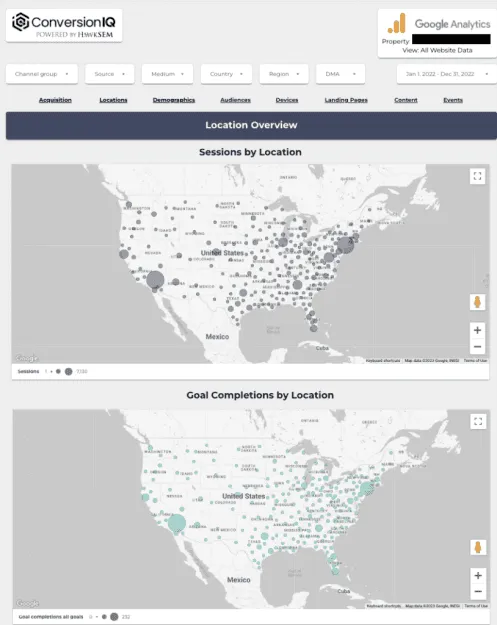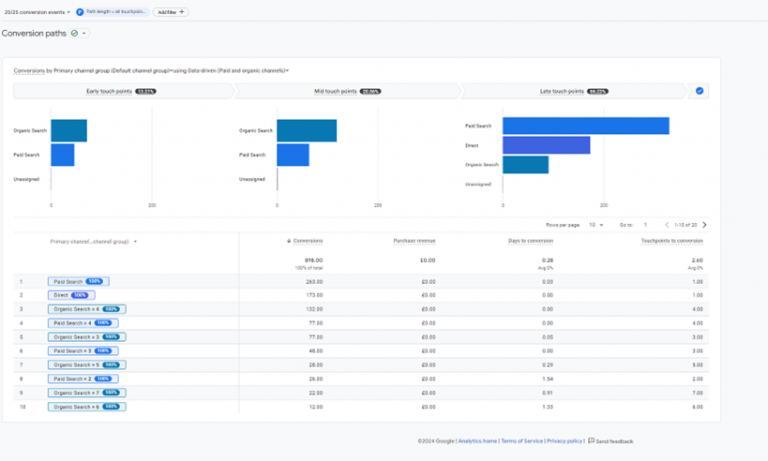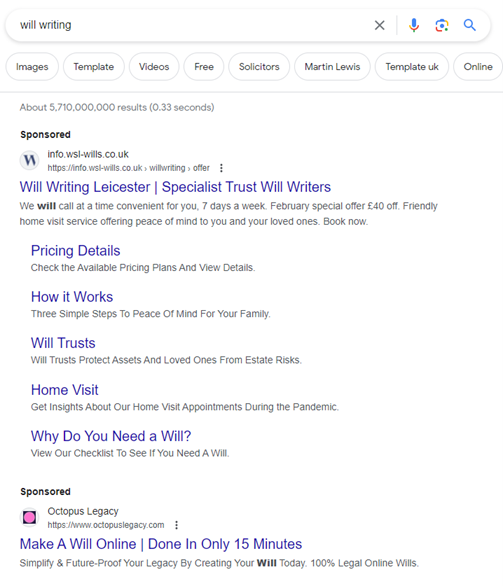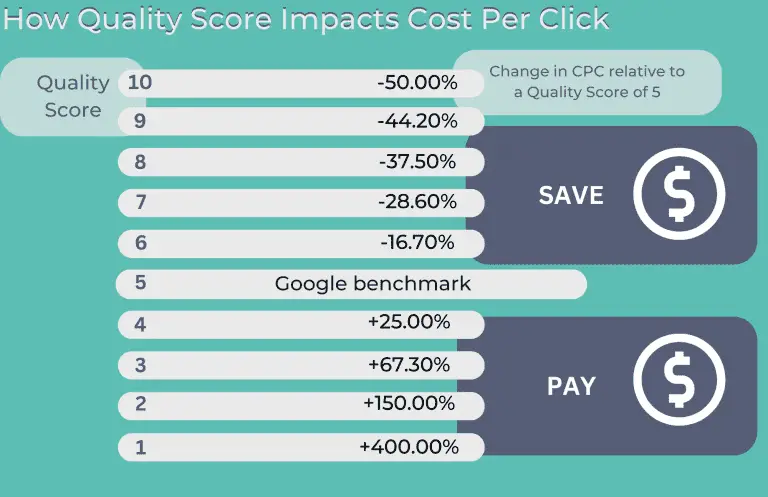PPC tracking allows you to see which ads are driving clicks and conversions, and which aren’t. Discover what metrics to measure, PPC tracking software to use, and expert tips to make your campaigns drive more clicks.
Here, you’ll find:
- What is PPC tracking?
- How to track PPC campaigns
- Expert tips for PPC tracking
- Why is PPC tracking important?
- What metrics you need to track
- The best tool to use
There’s a phrase that goes, “You can’t improve what you can’t measure.”
By monitoring and tracking your digital marketing channels, you’re well-equipped to see what your target audience consumers and what you can do to get more leads.
Pay-per-click (PPC) advertising is designed for tracking. These platforms gather lots of valuable data — you just need to capture and monitor it.
Not sure how to track conversions? In this article, we’ll discuss the benefits of PPC ad tracking, help you determine the best key performance indicators (KPIs) to watch, and provide expert tips for tracking PPC like a pro.
What is PPC tracking?
PPC tracking is the process of collecting and analyzing data to evaluate the performance of your PPC campaigns.
It involves:
- Identifying the metrics you want to monitor
- Modifying your PPC account to track the correct data
- Analyzing the data you collect
- Optimizing your campaigns based on the results of your PPC tracking
PPC tracking isn’t a one-off process. It’s something you need to do continually to ensure your PPC ads are visible and collects clicks.
This article predominantly focuses on Google Ads. However, we’ll also mention other PPC platforms like Microsoft Advertising (Bing Ads) and paid social platforms like Facebook, Instagram, and LinkedIn.
How to track PPC campaigns
Your PPC campaigns must be set up correctly to get the right data in the right place at the right time. No tracking, or incorrect tracking, can lead to disastrous results.
Kuban Baryktabasov, CEO of NAO, has a cautionary tale about the dangers of not tracking.
“A few years ago, one of my companies launched a new product and allocated a large budget to promote it on social media,” explains Baryktabasov. “Initially the PPC campaign seemed successful — we were getting a high number of clicks and a steady flow of traffic to our website.
After a few weeks, his team realized they’d neglected to track how many website visitors were buying the company’s product, meaning they didn’t know if their campaign was successful or not.
“We were able to optimize the campaign and add the right tracking,” he adds, “but not before wasting a significant amount of money.”
Here are ways to implement PPC tracking for your business:
- Conversion tracking pixels. These are tiny pieces of code you embed on your website or in Google Tag Manager. They trigger when a specific action occurs, for example, a sale takes place, someone clicks a call-to-action button, or someone downloads your app.
- Call tracking. Call tracking for PPC campaigns allows you to track when someone calls your business through a PPC ad. You can also track the number, phone call length, and time of the call.
- UTM parameters. These codes are added to the end of your URL, providing additional context about where your website traffic came from. You can use them to say which PPC platform, keyword, or campaign drove the click. You can capture and analyze this information within Google Analytics.
![]()
Expert tips for PPC tracking
We’ve looked at how to track PPC campaigns and the best keyword tracking software to use, but what else can you do to get the most out of your PPC advertising?
We asked our PPC experts, as well as PPC specialists worldwide, to share their thoughts.
Here are their top tips:
- Understand your goals
- Structure your tracking clearly
- Segment your tracking
- Review your PPC campaigns regularly
Understand your goals
Before building your PPC campaign and implementing PPC tracking, you need to:
- Know which KPIs you want to track. It can often help to have a “North Star metric” in place — one KPI that measures your long-term success and guides your team towards success.
- Have the right goals in place. These need to be SMART — specific, measurable, attainable, relevant, and timely.

With a plan, you’re better prepared to track your PPC accounts and understand how to get the right results.
Carl Broadbent, a web developer and digital marketing expert, is a firm believer in knowing what you want to achieve from your campaigns.
“One ecommerce client saw a 300% ROI by focusing on repeat customer acquisition rather than one-time purchases alone,” he explains. “We attributed this to optimizing ads based on multi-session tracking and improving retargeting efforts.”
Structure your tracking clearly
Having a well-structured PPC account makes it easier to track metrics and identify which ads are bringing the best results. It also means you save time optimizing your campaigns.
Here are some ways you can structure your account to optimize your tracking:
- Group campaigns based on specific goals (for example, conversions or brand awareness)
- Use consistent naming conventions to identify the purpose and theme of campaigns, ad groups, and keywords
- Use STAGS (single theme ad groups) and SIAGs (single intention ad groups) to make it easier to identify high-performing keywords
- Labels mean you can add additional information, making segmentation and reporting easier
- If you use UTM parameters, add them all to a spreadsheet everyone in your marketing team can access. This reduces the risk of replication.
Segment your tracking
Want to see which countries drive the most conversions or what time of day leads to the most clicks?
Segmenting your campaign data can provide valuable insights and determine which ads deliver the best results.
You can segment your Google Ads data using predefined segments by accessing the relevant report and clicking the Segment button.
![]()
Alt text: Segment button within the Google Ads dashboard
Review your PPC campaigns regularly
After setting up PPC tracking, regularly review your campaigns to identify and fix potential issues before they cause major problems. Also, keep an eye on your competitors to ensure they don’t steal your impression share.
Teresha Aird, CMO at Custom Neon, is an advocate of optimizing your campaigns as you go.
“By monitoring our KPIs closely, we could adjust bids and ad copy in real-time,” she says. “This led to a 40% increase in ROI within the first quarter of launch.”
How often should you review your PPC account? It depends on the size and length of your campaign, as well as how competitive your industry is.
Most PPC platforms will let you set up notifications which alert you to any urgent issues. For example, Google Ads can let you know if your clicks or conversions suddenly drop below a predetermined level.
The best tools for PPC tracking
A great place to start your PPC tracking: on the advertising platforms you run your ad campaigns on.
Google Ads, Microsoft Advertising, and Meta Business Suite provide detailed tracking and reporting at no extra cost. You can set up your dashboards to review important metrics, and visualize your data.
Native platforms also allow you to run A/B testing to track two different versions of an ad to see which performs best.
Of course, the more data you have, the better the decisions you can make. Here are examples of PPC tracking software you can use in your campaigns.
ConversionIQ
ConversionIQ (CIQ) is exclusive to HawkSEM.
We created it so our customers could track the success of their marketing channels at any time, and combine analytics from different PPC platforms. For example, you can use it to see how your Google Ads and Microsoft Advertising campaigns are working together.

“Tracking is an essential part of any marketing campaign,” says HawkSEM CEO Sam Yadegar. “We use ConversionIQ to track every step of the buyer journey to understand what touchpoints are working and what needs optimizing. This allows us to work towards a higher ROAS for our clients.
CIQ combines PPC data with data from other marketing channels, such as search engine optimization (SEO), to help businesses scale even further. By using CIQ and the agency’s PPC optimization services, AppDynamics doubled its targeted traffic and increased its conversions by 20%.
Google Analytics
Google Analytics is great for two specific reasons. First, if you use UTM parameters to track your ads, you can track whether these clicks lead to conversions, as well as investigate the journey taken through your site.
Second, Google Analytics offers attribution reports. Some customers may interact with multiple ads on different platforms, and attribution reports identify which ads to give credit to for conversions.
While attribution reports are also available on Google Ads, Google Analytics offers broader attribution capabilities, letting you see how organic traffic, social media, and paid social impact conversions.

Semrush
While Semrush is primarily known for keyword research and SEO, it also provides valuable PPC tracking insights.
The position tracking report lets you see which PPC keywords you and your competitors are ranking for, while the PLA research tool provides insights into how to improve your Google Shopping account.
![]()
Want to know more? Check out our comprehensive guide to the best PPC tracking software around.
Why is PPC tracking important?
Tracking PPC campaigns helps you make data-driven business decisions and see what ads resonate with your audience’s needs.
All businesses are different — while there is plenty of data out there about the benefits of PPC ads, you might not find this data applies to your specific circumstances.
For example, Google claims that the average return on investment (ROI) for Google Ads is 200%, but this might not be relevant to your industry or the products or services you offer.
PPC tracking allows you to identify the relevant metrics for your business that matter.
Dave Kerr, Advertising Specialist at Merged Dental Marketing, uses PPC tracking to make the right choices for his clients.
“I once worked with a client who was struggling to generate leads through their PPC marketing,” shares Kerr.
“After implementing tracking and analyzing the data, we discovered that most conversions came from customers clicking on ads during their lunch break. We then adjusted the ad schedule to target customers during that time frame, leading to a significant increase in the number of conversions.”
What metrics you need to track
PPC tracking can identify what’s working in your ad campaigns, but it’s vital to identify the right KPIs.
Here are the PPC metrics to monitor your campaign performance:
- Ad position
- Average order value (AOV)
- Cost per click (CPC)
- Click-through rate (CTR)
- Conversion rate
- Impression share
- Quality Score
- Return on ad spend/Profit on ad spend (ROAS/POAS)
Ad position
Ad position refers to the ranking of your ad compared to other ads.

While ad position is easy to track, it doesn’t tell you a lot on its own. For example, a competitor that bids significantly more than you is generally more likely to outrank you.
Ad position works best when combined with other key metrics. For example, a high impression share coupled with a low ad position may indicate there’s a lot of competition for your keyword.
Average order value (AOV)
Average order value (AOV) tells you the average amount of money a customer spends per transaction. You measure it by devising your total revenue by the total number of orders.
You can implement conversion tracking on your website to get this information. We’ll talk about conversion tracking in more detail later.
A high AOV means customers spend more money on each order. This shows you’re targeting the right customers and your marketing campaigns are effective.
Cost per click (CPC)
Cost per click (CPC) shows how much you pay per click on your PPC ad. You measure it by dividing the total cost of your PPC campaign by the number of clicks it receives.

All PPC platforms will show your CPC as standard. In Google Ads, you can view it by keyword, ad group, and campaign, or by other segments like device and time of day.
A high CPC doesn’t necessarily mean poor performance. It’s important to analyze it alongside other metrics. For example, a high CPC and a low AOV may mean you need to optimize your campaign.
Click-through rate (CTR)
Click-through rate measures the percentage of people who see your ad and click on it. You measure it by dividing the number of clicks your PPC advert receives by the number of impressions and multiplying by 100.
All PPC platforms show your CTR in your reports and dashboards, and you can drill down by segment.
The higher your CTR, the more engaging your ad. You can also use CTR alongside other metrics. For example, a high CTR and a low conversion rate may indicate that while people love your ad, they don’t like the landing page it points to.
Conversion rate
Conversion rate measures the percentage of people who click on your ad and take a desired action. You measure it by dividing the percentage of conversions your ad receives by the number of clicks and multiplying by 100.
You can also calculate your cost per conversion, or the average amount you pay for a user to take a desired action. Set up conversion tracking on your website to monitor the conversion rate on your PPC platform of choice.
You want your conversion rate to be as high as possible — a low conversion rate can show you’re targeting the wrong audience or the user experience on your website is poor.
Impression share
Impression share tells you the percentage of times your ad was eligible to appear versus the total number of times it was shown. You measure it by dividing the number of impressions by the number of eligible impressions and multiplying by 100.
Impression share is automatically tracked and measured in all PPC platforms.
A high impression share indicates your ad appears frequently in all the relevant searches. However, a very high impression share can be a bad thing, as it shows you’re not bidding competitively or are targeting irrelevant keywords.
You can improve your impression share in Google Ads by taking advantage of ad extensions, understanding when your target audience is most active on Google, and using long-tail keywords.
Quality Score
While Quality Score isn’t an official KPI, it’s still worth monitoring.
In Google Ads, Quality Score refers to the relevance of your ads and keywords, and the landing page experience.
Google Ads keeps the algorithm it uses to calculate Quality Score under wraps, which it uses to assign each of your keywords a score out of ten. A higher score provides additional benefits, including a lower CPC.

The Meta (Facebook and Instagram) equivalent is called ad relevance diagnostics.
Return on ad spend/Profit on ad spend (ROAS/POAS)
Return on ad spend (ROAS) is an overarching metric that tells you how much revenue you generate for each dollar you spend. You measure it by dividing the revenue you receive from ads by the cost of the ads.
You need to set up conversion tracking to measure ROAS in Google Ads.
A high ROAS means your ad campaigns are generating good revenue. A good ROAS can vary from x1.5 to x10 depending on your industry and business goals.
An alternative to ROAS that’s gaining popularity is profit on ad spend or POAS. Instead of measuring revenue (money generated before expenses), you measure profit (money generated after expenses).
While POAS is trickier to calculate, it can be more accurate since it accounts for high campaign overheads.
The takeaway
Tracking PPC may sound complicated, but it doesn’t have to be. Being organized is the key — pick a handful of metrics to investigate and plan time in your calendar to review the data.
Our final tip? Track your data from the very start — this will save time and stress later!
If you’re still not sure where to begin with PPC ad tracking, we can help. Our PPC specialists will set up and manage your campaigns with your chosen KPIs in mind, providing jargon-free reporting so you always make the right decisions.
Get in touch today, and let’s transform how you use PPC advertising.


